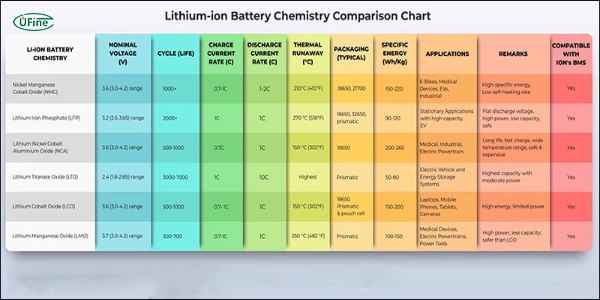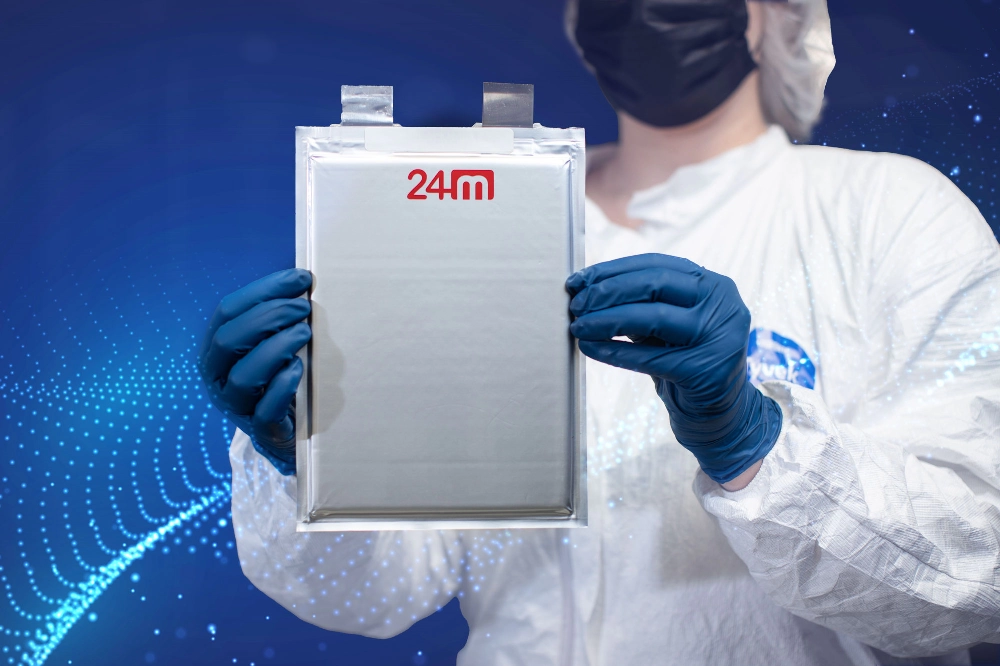Lithium batteries come in various types, often categorized based on the cathode and anode materials. Additionally, lithium batteries can be classified according to their appearance, casing materials, and cell construction. In this article, we will explore different types of lithium batteries and their respective advantages and disadvantages.

Part 1: Lithium Cobalt Oxide (LiCoO2) (LCO)
Lithium Cobalt Oxide (LiCoO2) batteries are a type of lithium-ion battery widely used in portable devices. While Lithium Manganese Oxide (LMO), Lithium Nickel Manganese Cobalt Oxide (NMC), and Lithium Iron Phosphate (LFP) batteries are also popular, LCO batteries stand out for their charging performance. They have a stable structure, high energy capacity, and reliable performance. However, they are relatively unsafe and expensive. This type of battery is mainly used in small to medium-sized devices.
LCO Battery Parameters:
- Nominal Voltage: 3.6V
- Operating Voltage: 3V – 4.2V
- Specific Energy: 150 Wh/kg to 200 Wh/kg
- Charge Rate: 0.7-1C, typically charges to 4.2V in 3 hours
- Discharge Rate: 1C, with a cut-off voltage of 2.5V; higher discharge currents will shorten battery life
- Cycle Life: 500 to 1000 cycles
- Thermal Runaway: 150°C
Advantages of LCO Batteries:
- Excellent electrochemical performance
- High processing performance
- High tap density, resulting in high volumetric capacity
- Stable product performance and good consistency
Disadvantages of LCO Batteries:
- Low energy density
- Prone to thermal runaway
- High manufacturing cost
Uses:
Lithium Cobalt Oxide (LCO) batteries are primarily used in cell phones, laptops, and other portable electronic devices.
Part 2: Lithium Manganese Oxide (LiMn2O4) (LMO)
Lithium Manganese Oxide (LiMn2O4) batteries use lithium manganese oxide as the cathode material. These batteries are cost-effective, have high safety, and are widely used in various applications. The performance and characteristics of lithium manganese oxide batteries may vary depending on the production method and materials used.
LMO Battery Parameters:
- Nominal Voltage: 3.7V
- Operating Voltage: 3V – 4.2V
- Specific Energy: 100 Wh/kg to 150 Wh/kg
- Charge Rate: 0.7-1C, typically charges to 4.2V in 3 hours
- Discharge Rate: 1C, with a cut-off voltage of 2.5V
- Cycle Life: 300 to 700 cycles
- Thermal Runaway: 250°C
Advantages of LMO Batteries:
- High thermal stability, making them safer
- Low internal resistance, enabling fast charging and high current discharge
- Good low-temperature performance and easy to manufacture
Disadvantages of LMO Batteries:
- Low energy storage capacity
- Short cycle life
- Sensitive to high temperatures
Uses:
Lithium Manganese Oxide (LMO) batteries are commonly used in power tools, medical equipment, and hybrid or electric vehicles.
Part 3: Lithium Nickel Manganese Cobalt Oxide (LiNiMnCoO2 or NMC)
Lithium Nickel Manganese Cobalt Oxide (LiNiMnCoO2 or NMC) batteries use a mixture of nickel and manganese, along with a small amount of cobalt, making them more affordable than lithium cobalt oxide batteries. This combination provides performance comparable to Lithium Cobalt Oxide batteries, making them an increasingly popular choice in modern batteries and a gradual replacement for LCO batteries.
NMC Battery Parameters:
- Nominal Voltage: 3.6V
- Operating Voltage: 3V – 4.2V
- Specific Energy: 150 Wh/kg to 220 Wh/kg
- Charge Rate: 0.7-1C, typically charges to 4.2V in 3 hours
- Discharge Rate: 1C, with a cut-off voltage of 2.5V; some cells can support 2C discharge
- Cycle Life: 1000 to 2000 cycles
- Thermal Runaway: 210°C
Advantages of NMC Batteries:
- High energy density and high voltage platform
- Excellent cycle performance and long lifespan
- Low self-discharge and no memory effect
Disadvantages of NMC Batteries:
- Sensitive to high temperatures
- Prone to thermal runaway
- The environmental impact of nickel and manganese mining
Uses:
Lithium Nickel Manganese Cobalt Oxide (NMC) batteries are used in new energy vehicles, electric vehicles, power tools, energy storage systems, smart vacuum cleaners, drones, wearable devices, and more. For more information on energy storage systems, check out our Home Energy Storage Systems guide.
Part 4: Lithium Iron Phosphate (LiFePO4)
To be continued…
Lithium Nickel Cobalt Aluminum Oxide Battery (LiNiCoAlO2 or NCA)
Lithium Nickel Cobalt Aluminum Oxide (NCA) batteries have been in use since 1999. They are known for their high specific energy, good specific power, and long lifespan, similar to NMC batteries. However, their safety and cost factors may be less favorable.
NCA Battery Parameters:
- Nominal Voltage: 3.6V
- Operating Voltage: 3V – 4.2V
- Specific Energy: 200 Wh/kg to 260 Wh/kg
- Charge Rate: 0.7C, typically charged to 4.2V in 3 hours
- Discharge Rate: 1C, with a cutoff voltage of 3V
- Cycle Life: 500 cycles
- Thermal Runaway: 150°C
NCA Battery Advantages:
- High energy density and high voltage plateau
- Good cycle performance and long lifespan
- Low self-discharge and no memory effect
NCA Battery Disadvantages:
- High production costs
- Sensitive to high temperatures
- Environmental impact due to the extraction and processing of nickel, cobalt, and aluminum
NCA Battery Applications:
NCA batteries are primarily used in electric vehicles.
Lithium Iron Phosphate Battery (LiFePO4)
Lithium Iron Phosphate (LiFePO4) batteries are a type of lithium battery. They are widely used in devices such as mobile phones, with the cathode primarily composed of lithium iron phosphate compounds.
LiFePO4 Battery Parameters:
- Nominal Voltage: 3.2V
- Operating Voltage: 2.5V – 3.65V
- Specific Energy: 90 Wh/kg to 120 Wh/kg
- Charge Rate: 0.7-1C, typically charged to 3.65V in 3 hours
- Discharge Rate: 1C, with a cutoff voltage of 2V – 2.5V (some battery cells can reach 25C)
- Cycle Life: 2500 cycles
- Thermal Runaway: 270°C
LiFePO4 Battery Advantages:
- Excellent safety performance
- Long lifespan
- Good high-temperature performance
- Large capacity and no memory effect
LiFePO4 Battery Disadvantages:
- Relatively low energy density
- Poor electrical conductivity and slow lithium-ion diffusion rate
- Poor low-temperature performance
- The overall cycle life of a battery pack may be lower than that of a single cell.
LiFePO4 Battery Applications:
Due to their unique properties, LiFePO4 batteries are used in large electric vehicles, power tools, solar and wind energy storage systems, UPS systems, emergency lighting, warning lights, and mining lamps, replacing small medical equipment and portable instruments.
Lithium Titanate Battery (Li4Ti5O12)
Lithium Titanate (LTO) batteries use lithium titanate instead of graphite as the negative electrode in typical lithium-ion batteries, forming a spinel structure. The positive electrode can be lithium manganese oxide or NMC.
LTO Battery Parameters:
- Nominal Voltage: 2.4V
- Operating Voltage: 2.5V – 3.65V
- Specific Energy: 50 Wh/kg to 80 Wh/kg
- Charge Rate: 0.7-1C, typically charged to 3.65V in 3 hours
- Discharge Rate: 10C, with a cutoff voltage of 1.8V
- Cycle Life: 3000 – 7000 cycles
- Thermal Runaway: 175°C to 225°C
LTO Battery Advantages:
- Superior safety performance
- Extremely long cycle life
- Wide operating temperature range (high and low temperatures)
- High power output
- Low cost
- Environmentally friendly technology
LTO Battery Disadvantages:
- Low energy density of lithium titanate material
- High water absorption
- Battery production has high environmental requirements
LTO Battery Applications:
LTO batteries are commonly used in UPS systems, electric powertrains, and solar street lights.
Lithium-Ion Battery Shape Classification
In addition to classification based on positive and negative electrode materials, lithium-ion batteries can also be classified by shell material, shape, and type.
By Shell Material:
- Steel Shell Battery: The battery casing is made of steel.
- Aluminum Shell Battery: The battery casing is made of aluminum.
- Polymer Lithium Battery: The shell is made of polymer material, with various colors, some silver or black.
By Shape:
- Cylindrical Battery: Commonly used in laptops, power banks, and other devices.

Battery Types and Their Applications Explained
Cell Combinations
Tesla’s use of over 7,000 18650 cells in series and parallel configurations demonstrates the versatility of battery arrangements in high-performance applications. Other companies often use fewer combinations, such as five or six, depending on their needs.
Square Batteries
Square batteries are commonly made from polymer, a highly malleable material that can be formed into various shapes. The length, width, and height of these batteries can be customized to meet the specific needs of different devices. Polymer batteries are particularly popular in today’s digital products due to their versatility.
Special-Shaped Batteries
Certain products require batteries with unique shapes, such as smart wearables like smart bracelets, where the battery can be manufactured in ring shapes or other custom designs. These special-shaped batteries are designed to fit the specific form factor of the device.
By Cell Type
18650 Cell
The 18650 lithium-ion cell is a widely used battery type that measures 18mm in diameter and 65mm in length. It is a cylindrical cell that has been extensively developed and can be used in a variety of devices. While compact and reliable, the 18650 cell offers lower safety compared to some alternatives and typically sustains around 300 charge cycles.
Polymer Cell
Unlike traditional lithium-ion batteries, which can be soft and flexible, polymer batteries have a more rigid form factor. These batteries are safer and often provide a longer lifespan, exceeding 500 charge cycles. However, they come at a higher cost—typically twice the cost of an 18650 lithium-ion cell with equivalent capacity.
Section 8. FAQs
Which lithium battery is best?
The best type of lithium battery depends on the specific application. For example, Lithium-ion (Li-ion) batteries are commonly used in everyday electronics, while Lithium Iron Phosphate (LiFePO4) batteries are well-suited for high-power applications like electric vehicles.
Which battery is the safest?
Lithium Iron Phosphate (LiFePO4) batteries are known for being one of the safest lithium-ion battery chemistries. Its stable chemistry reduces the likelihood of overheating or thermal runaway.
What are the 3 main types of batteries?
The three main types of batteries are Lithium-ion (Li-ion), Nickel-Metal Hydride (NiMH), and Lead-Acid batteries, each offering unique features and suitable for different applications.
How to choose the lithium battery?
When choosing a lithium battery, consider factors such as voltage, capacity, size, weight, and the specific requirements of your device or application. Ensure the battery is compatible with the intended application.
Which is better: Li-ion or LiPo?
The choice between Lithium-ion (Li-ion) and Lithium Polymer (LiPo) batteries depends on the application. Li-ion batteries are widely used in everyday electronics, while LiPo batteries are better suited for devices requiring flexible form factors, such as slim gadgets and wearables.
Can I Bring Lithium Batteries on a Plane?
Yes, you can bring lithium batteries on a plane, but there are some restrictions. This guide outlines the rules that airlines follow, key safety precautions, and tips for packing lithium batteries for air travel. If you are interested in learning more about the unique advantages of lithium batteries, check out our article on The Unique Advantages of Keheng Lithium Batteries.
A Simple Guide: Choosing the Right Battery for Your Garden Tractor
Not sure which battery is right for your garden tractor? Find the perfect battery to keep your lawn tractor running smoothly! Read on to learn more.







